Giovanni dall'Agocchie: Part 1
The Life and Times of a Late 16th Century Sword Master: A Case of One Too Many Giovannis.
The search for the late 16th century sword master Giovanni dall’Agocchie has hit an interesting crossroads. The good news is we’ve found him, and we even know where he lived—the problem is there are two men named Giovanni dall’Agocchie and we need to figure out which one is the correct Giovanni.
At the turn of the 16th century, there were three active dall’Agocchie branches in Bologna; the Ancient family, the Spagnoli or Spanish branch (butchers), and the Drapieri branch (Cloth merchants). In this article, I'm going to share with you all of the information that I have gathered so far with the objective of open and transparent research. This is so, if I leave this thread hanging or if someone really passionate about Giovanni dall’Agocchie wants to start their own research endeavor, they have the means to build on what I’ve started here.
A quick note on Guisepe Guidicini, Cose Notabili della Città di Bologna. (1868-1873): this is a source that was for—all intents and purposes—ambitious, and it has a number of errors that have been noted and corrected by later scholars. That said, what Guidicini put together is an amazing resource which only suffers due to the size, scope, and reach of the project. This man scoured the historical records of the city to put together a comprehensive timeline of every house, palazzo, garden, street, and church in the city of Bologna. It's imperfect, but it's incredibly valuable.
As always I've balanced this articles reliance on Guidicini with a healthy dose of Dalla Tuata, Ghirardacci, and Vizzani, along with a number of secondary sources that were useful for the completion of this project.
Let's get into it!
The dall'Agoccie Spagnoli (Butchers):
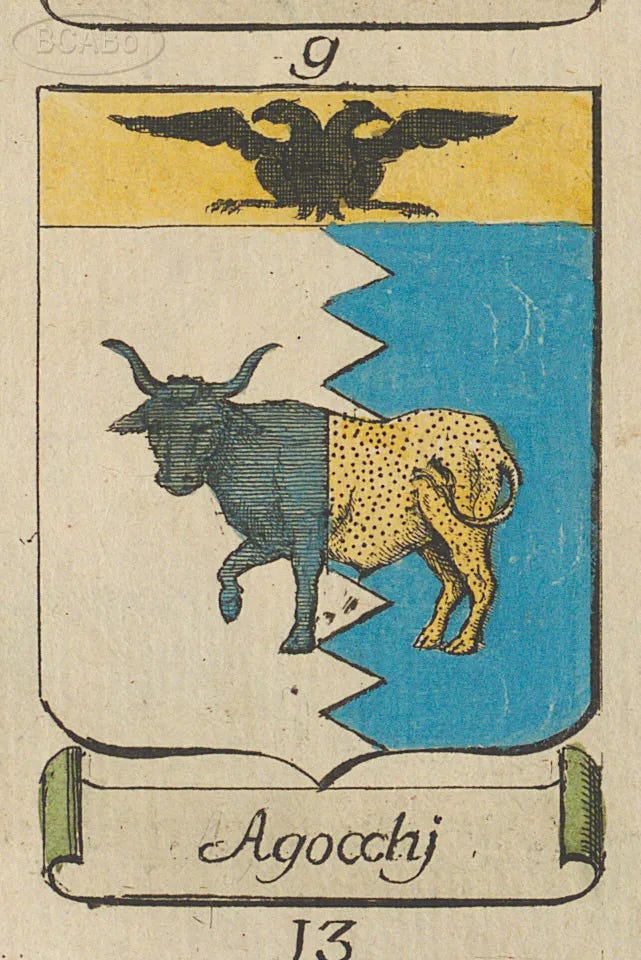
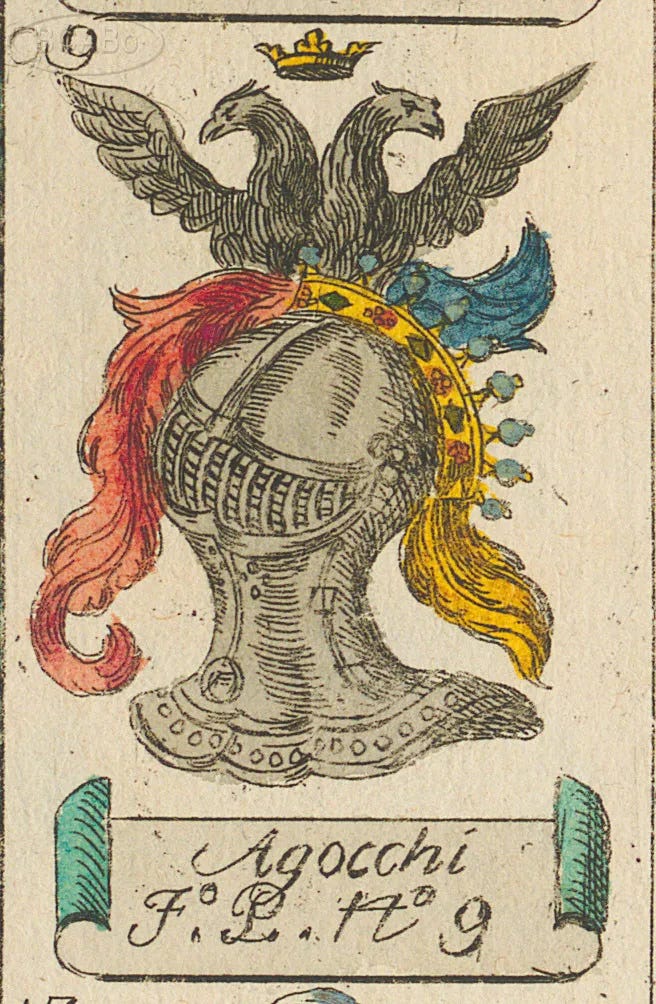
The Spagnoli branch first shows up in the chronicles of the city in 1454, with Tomasso dall’Agocchie, a butcher. Ghirardacci notes that he gifts Sante Bentivoglio six barrels of white wine for his wedding.1 Tomasso owned a home at 29 via Zamboni, in the district of San Stefano, near the rich and influential San Donato neighborhood. The Palazzo was adjacent to some of the Bentivoglio’s property, and in 1474 Tomasso’s son Clemente was given a stipend of 100 Bolognese lira when a fire broke out in Giovanni II’s stables and destroyed some property belonging to the dall'Agocchie family.2
Clemente’s sons—I believe —were Francesco, Sebastiano and Frederico; there could be more or less—hard to say. Francesco di Clemente dall’Agocchie was baptized in October of 1460, and his Godfather was Giovanni II Bentivoglio.3 He attended the University of Bologna, where he graduated with a degree in Civil law in 1485. He took on a role lecturing at the University in 1486, and eventually took a position in the civil law program in 1493 and would continue in that role until his death on the 7th of November 1503.4 Guidicini records that Francesco was a member of the ancient family, but University register notes that he was the son of Clemente, so I've included him in the Spagnoli branch.
Sebastiano dall'Agocchie was a key member of the Bentivogleschi faction, who served as either a clerk or an accountant for Giovanni II Bentivoglio. He first appears in the Bolognese Chronicles in 1497, where the two of them enjoyed a meal and listened to the ring of a bell that had just been cast and hung in a nearby tower.5
(O)n the 15th, Giovanni Bentivoglio's tower was raised, and on the 17th it was rung so that he, who was having dinner in San Donino in the company of Bastiano delle Agocchie, could hear it’s splendor.
Ghirardacci, pg. 293
Sebastian was deeply loyal to Giovanni II, and as his accountant he was privy to many of the Signoria’s most intimate state secrets, but their relationship took a turn in 1505-1506 when Pope Julius II started to pressure Giovanni II to abdicate his position in Bologna. This was was further inflamed by the fact that Giovanni owed an outstanding debt of 2,500 ducats to dall’Agocchie, which he refused to pay, causing Sebastiano to flip on his friend and employer.6
According to the Bolognese Chronicles and the Archival records of the curia, Sebastiano followed the lead of the famed knight, and Bolognese ambassador Carlo Grati; who was sent to Rome on behalf of of the Regimento (Sedici), and turned his ambassadorial duties into an tell-all that earned him a papal pardon, and a position in the curia.
On a surface level, Sebastiano’s accounts of the Malvezzi coup and Marescotti conspiracy were enough to encourage His Beatitudes to act against Giovanni, but he garnished his testimony with something a bit more sinister, implying that Giovanni II and his wife Ginerva Sforza Bentivoglio, had poisoned Sante Bentivoglio (who was married to Ginerva at the time); then acting as regent, in order to wed and reign in perpetuity. Here is Ghirardacci's account:7
(I)t therefore happened that Giovanni Bentivogli, having sent Carlo Grati, a knight and member of the Sedici, to Rome as his referendum to the Pope, hoping that he would do a profitable job to obtain the grace of the Pope for his regimento, but Carlo did the complete opposite of what Giovanni had ordered him to do; and instead attempted, with the favor of certain friends of his, to be made a senator of Rome, to which the Pope easily gave in, and also gave him a wife of great kinship who provided him with a very good dowry. Now made allied with the pontiff, and often speaking with him, he sometimes questioned him about the nature of Giovanni Bentivogli; and Carlo always spoke of all the evils he had witnessed, assuring him that Giovanni did everything he desired in the city, without considering whether it was right or wrong.
It so happened, in confirmation of what he had said to the pontiff, that Sebastiano dall'Agocchia, who was secretary to the aforementioned Giovanni, left Bologna due to some dispute, and on account that he was a friend of the pope, he passed to Rome, visiting the pontiff. In discussion of Giovanni's situation, he confirmed everything that Carlo had told him and added greater evil to his testimony, by telling him that he held the Malvezzi exiles from Bologna against reason, and showed himself to be a very cruel man in opposition to them. The Pope, hearing these complaints, decided that he wanted to hold him to account for his many evils; and only a few days passed before he had Giovanni Bentivogli and all his sons summoned to Rome.
—Ghirardacci, pg. 344
And according to the Ristretto delle croniche di Bologna, BUB ms. 81, summarized by Elizabeth Louise Bernhardt, in her paper, Generva Sforza and the Bentivoglio: Family, Politics and Reputation in Renaissance Bologna:
Once he established himself in Rome to work for his new patron Julius II, former Bentivoglio treasurer and partisan Sebastiano delle Agocchie invented a number of stories about the Bentivoglio. Although most of his accounts were about the family in general, Agocchie introduced the claim that Genevra’s first husband Sante had not died of natural causes but had been poisoned by those closest to him (7 suoi piu propinqui).
(Bernhardt, pg. 265-266)
Of course, Sebastiano didn't go to Rome alone, he brought along the Bentivogleschi notary, Giacomo Budrioli. Its not clear what Giacomo Budrioli’s relationship was to Gentile Budrioli, the convicted witch, necromancer, and healer who was burned at the steak in 1497, but the inclusion of Budrioli in the excursion to incriminate Giovanni and Ginerva is highly suspicious to me.
For Sebastiano’s loyal service to His Holiness, he was given a place to stay in Rome, and I imagine a fairly robust guard detail, before returning to Bologna in November of 1506 with the Pope’s army. Once Julius II’s soldiers had firmly established themselves in the city, Sebastiano was given command of the San Mammolo Gate.
He {the Pope} gave the city gates to the citizens listed below: the gate of San Felice to Alessandro dalla Volta; strà Santo Stefano to Filippo de' Vitali; Zaragoza to Giovanni de 'Marsili; San Vitale to Giovanni Antonio Gozzadini; Mascarella to Giovanni Begliossi; San Mamolo to Sebastiano dall'Agocchie; Maggiore to Carlo Grati; Lame to Bartolomeo Zambeccari; Castiglioni to Filippo dalla Croce; San Donato to Giacomo....; Galliera was held by the archpriest to build the castle.
—Ghirardacci, pg. 357
Sebastiano’s recorded exploits in the Chronicles end there, however we know that he died in 1524, and his funeral was arranged by his nephew Bartolomeo dall'Agocchie.8 His estate, located at Via Marsala 34, was sold by Vincenzo Ghislardi. In the archival note about the posthumous sale of his home it's recorded that Sebastiano was a member of the Spagnoli branch of the dall’Agocchie family.9
While Sebastiano dall'Agocchie found refuge in the retinue of the pontiff, other members of dall’Agocchie family—whose relation to Sebastiano remain unclear—sided with the Bentivoglio and left Bologna in the retinue of Giovanni II Bentivoglio: namely Orabone and the prior of Santi Cosma e Damiano, Don Pierro dall'Agocchie (He passed in exile; Dalla Tuata: 370v).10 Orabone, and one Conte dall'Aggochie, would eventually return to Bologna in 1512, in the army of Annibale II Bentivoglio, but their story from that point forward is mostly undocumented.11
The family did remain active in the wake of the turmoil, but in order to build a narrative around the continuation of the dall’Agocchie legacy, we’ll have to rely mostly on municipal records compiled by Guidicini and the inventory of notaries collected by Ridolfi, rather than relying on historical exploits and fascinating stories—for now.
The home of Tomasso dall’Agocchie, our mid 15th century Butcher, at 29 via Zamboni remained in the family until 1605, when the inheritance was passed to, “the doctor of law, Francesco di Vincenzo Fioravanti, husband of Elisabetta di Federico Agocchia, his niece...”
From the records of licensed notai or notaries, found in the Invintario delle schede Ridolfi, we can piece-together the Federico branch of the Spagnoli family (Note: Dates correspond to registration and activity). Federico had a son named Ludovico di Federico who was registered in 1470, and actively served in a notorial role from 1489-1492. Ludovico had two sons, Frederico di Ludovico (1504; 1514-1547), and Ludovico di Ludovico (1528). It's from Frederico that we get the heiress, Elisabeta di Frederico Agocchie.
Similarly, from the same record we can derive the ancestry of Niccolò dall'Agocchie. In the register there are the following prospective descendants: Claudio di Niccolò dall’Agocchie (1518), Carlo Francesco di Niccoló dall’Agocchie (1547; 1553), Tomasso di Niccoló dall'Agocchie (1549), and one of our primary suspects—Giovanni Giorgio di Niccoló dall’Agocchie (1540-1586).
Suspect #1:
Giovanni Giorgio di Niccoló dall’Agocchie married Isabella Sega; Sister of the illustrious Cardinal Filippo Sega, and together they had two sons. Their eldest; Girolamo di Giovanni dall'Agocchie, was born on January 15th 1555, and their youngest; Giovanni Battista dall'Agocchie, was born on November 20th 1570.
Giovanni Giorgio was a registered notary, and signed off on the sale of a home in Strada Galleria (n.551) to Elesio dall’Agocchie on the 14th of August 1570. In 1621 the property was sold to Iacopo Pepoli.12
Girolamo graduated from the University of Bologna with a degree in Law, and became a notary for the Holy See, where he rose the through the ranks to become a Cardinal in June of 1604, after 30 years of service to the church.13 He participated in the conclave of Pope Leo XI, at the age of 51, but would pass away soon after, on the 27th of April 1605. An interesting note from the Historical-statistical-topographical manual of the Archdiocese of Bologna, states that he accompanied his uncle, Cardinal Filippo Sega, to Vienna for a nunciature of the Holy Roman emperor, and in a brief dated 21 May 1587, was conferred the privilege to add the Imperial Eagle to the families coat of arms.14 This is consequential because it confirms that the Spagnoli arms are indeed the bull on a field of blue and white divided by a sega depicted above.15
Giovanni Battista dall'Agocchie, would have an equally successful career in the vocation, thanks in large part to the ascendance of his older brother Girolamo. After spending some time as a secretary for Girolamo in Faenza and Rome, he studied at the Universities of Bologna and Sapienza. Giovanni Battista wouldn't quite reach the heights of his brother, thanks in large part to his fascination and devotion to matters of art and culture.
Remembered by many as the great chronicler of the early Baroque movement in Italy, Giovanni Battista spent much of his free time engaging with artists like Annibale Carracci, who was famously hired by the Bolognese Butchers guild to create a series of paintings depicting them in a positive light for what many have characterized as a public relations push around 1583.1617 He was also a close friend and admirer of Galileo Galilei.
The dall'Agoccie Spagnoli’s origins as butchers in Bologna shouldn't be lost on the reader, as the first notable member of the family was Tomasso dall'Agocchie, a butcher.18 Of consequence, we can relate Giovanni Giorgio di Niccoló dall’Agocchie and his sons to Tomasso’s legacy, and the Spagnoli branch because they were the ones who inherited the families estate at 29 via Zamboni, and bequeathed it to Elisabeta di Frederico Agocchie, when both of Giovanni’s sons entered the vocation, and Girolamo passed in 1605:
Via Zamboni 29 (N.2504)
From the “Notable Things …” by Giuseppe Guidicini.
House of Cardinal Girolamo and Archbishop Gio. Battista, brothers and sons of Gio. Giorgio Agocchi Spagnoli, a family that died out in the aforementioned archbishop of Amasia, who died on 27 April 1605. The inheritance passed to the doctor of laws Francesco di Vincenzo Fioravanti, husband of Elisabetta di Federico Agocchia, his niece, former brother.
A decree of the XVI Reformers, issued on 2 September 1474, granted compensation of L. 100 to Clemente, son of the late Tommaso Agocchi, for damages suffered in his house due to the fire that broke out the previous year in the adjacent stables of Giovanni Bentivogli.
The heir Fioravanti sold the aforementioned house to Count Boselli, and Count Girolamo Boselli ceded it in 1697 to Gio. Battista Piombini.
The Drapieri dall’Agocchie:
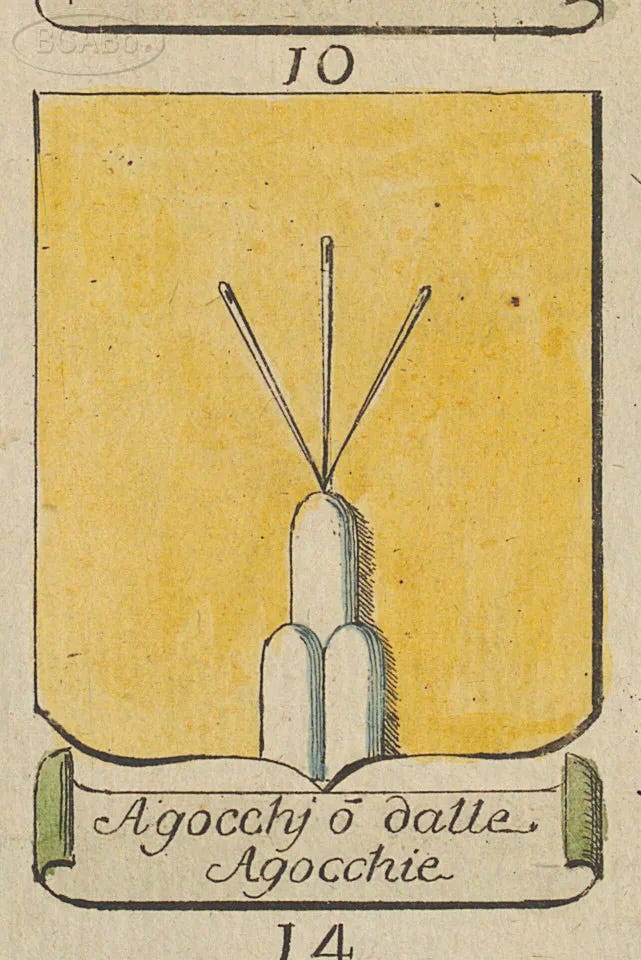
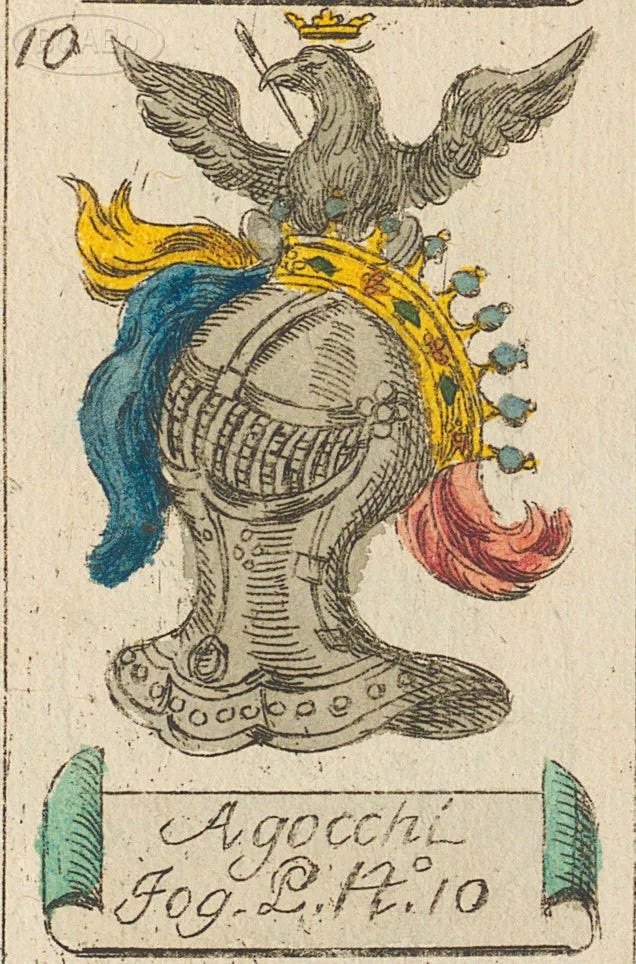
From the Spagnoli branch we now turn to the Drapieri branch of the family. Unfortunately not a lot of information has been recorded about this contingent of dall’Agocchie's. The most that I’ve been able to find so far is recorded in, Notable Things, by Giuseppe Guidicini, where he states, “On September 23, 1579, Annibale and Orazio Oricellario, along with Aloisio, son of Pandolfo Oricellario, {sold a house on Strada San Stefano} (N.108) to Giovanni dalle Agocchie for 24,700 lire, bounded by the nuns of the Trinity, the Seccadenari, via Coltellini, and others. Recorded by Girolamo Fasanini.”
This is our other prospective Giovanni dall'Agocchie. Guidicini continues that, “It is easy to confuse the three Agocchia families that existed in Bologna…The Agocchi Spagnoli family (see Via Galliera No. 550 and Strada S. Donato No. 2504). The Agucchi family of Strada Stefano were cloth merchants {Drapieri} and resided in the parish of S. Biagio in 1515, with some members practicing as notaries.”
The Palazzo in Strada San Stefano, today known as Palazzo Agucchi, would continue in the dall’Agocchie family until October 23rd 1749, when Fabio dall’Agocchie, “{left} his wife Ippolita, daughter of Count Giovanni Ferri Legnani, as the usufructuary and Count Donato, the younger son of Count Filippo Legnani Ferri and nephew of Ippolita, as heir. Donato was to assume the Agocchia name and arms.”
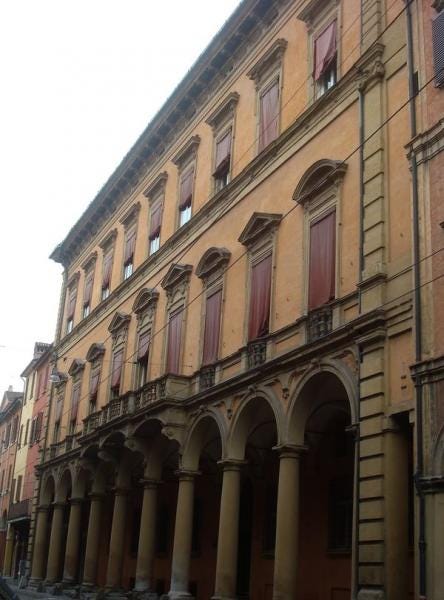
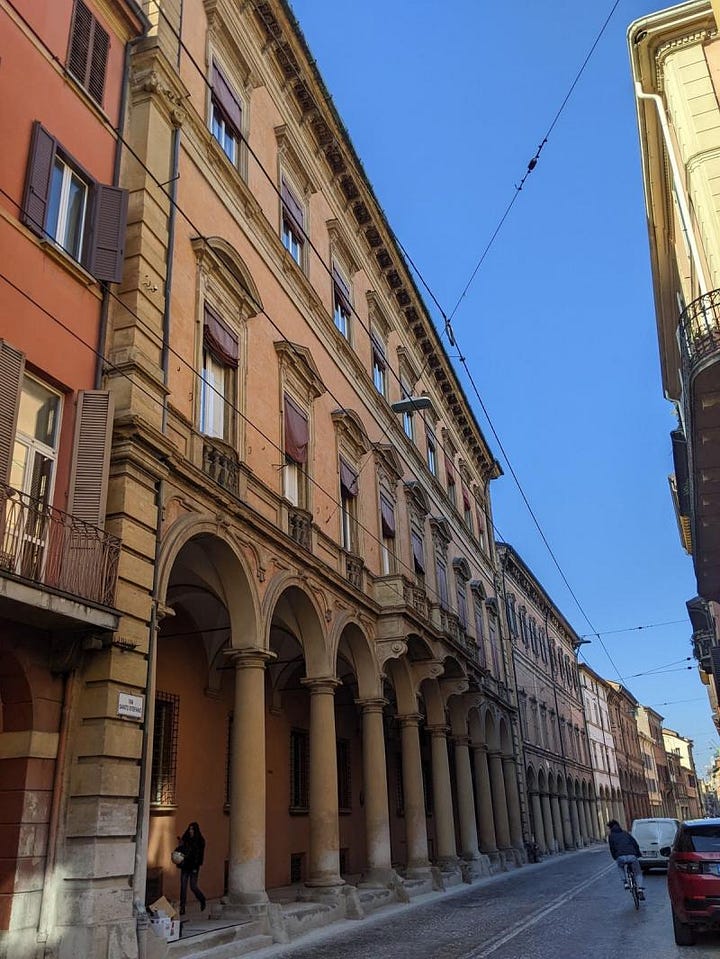
I've made the rather easy leap, and assumed that the Drapieri or Cloth Merchants branch of the family had a coat of arms bearing three mountains with three sewing needles on a field of gold—Ockham approves. Now let’s get to know our next Giovanni!
Suspect #2:
Giovanni di Paolo dall’Agocchie was quite the colorful character. In 1589 he was arrested by the local Inquisitor for striking an image of the Madonna, and heretical swearing {whatever that entails}.19 He was sentenced to three years in prison, but was soon let off with house arrest. However—Giovanni wasn’t interested upholding his oath to the church and went on the lam with his girlfriend; a woman who was a convicted witch and necromancer {Can't make this stuff up folks}.20 This accelerated the penalty of his charges to death in absentia, on account of, “contumacy and being a relapsed, impenitent heretic.” His assets, home and business were siezed by the Church while Giovanni and his heretical Bonny fled to Geneva, Switzerland. Unfortunately Giovanni blew his cover in the Alps and got picked up by the Swiss Inquisition, and his case was brought before Cardinal Santoro.
The Cardinal and his fellow Inquisitor requested all of the records of Giovanni’s case from the Roman office. However, upon reviewing the files they determined that the death sentence levied against dall’Agocchie was unfair, that his escape from house arrest was not a relapse and therefore the charges defied canonical decree. Thus, they restored all of Giovanni’s assets, property, and compensated him for any lost profits.
He didn't get off clean though, his case was re-adjudicated, and he was sentenced to five years on a papal galley—chained to an oar, while his original Inquisitor back in Bologna was reprimanded for illegitimate harshness for sentencing dall’Agocchie to death and seizing his property on behalf the church.21 Fortunately for Giovanni, on the 13th of March 1593, his sentence was commuted to a fine of 200 scudi by the Holy Office in Rome.22
Now that we’ve established our two Giovanni suspects, let's take a look at the remainder of the prospective families and build a sketch of what I've gathered so far!
The dall'Agocchie Alias
One rummaging through the records of Bolognese history will encounter a number of individuals using the dall’Agocchie surname as an alias. Most notably the dei Libri family, and the Montanaro family.
Of the Montanaro family, Guidicini records:
A document by Tommaso da Fagnano dated September 28, 1478, cites a Paolo di Giovanni Montanaro, known as dall’Agocchie, and on November 3, 1480, he is named Paolo di Giovanni Montanaro, alias dal Quattrina, alias dalle Agocchie. The surname dal Quattrina came from Madonna Justina Quattrina, widow of Paolo Montanaro and mother of Paolo Junior.
Of the di Libri family he notes:23
La via del Cane comincia dalla Piazza del Pavaglione, e termina alla via Larga di S. Domenico: N.1046
House, which according to the confinement of the following number, was in 1489 of the dei Libri family, of which Gasparo in 1420, and Gio. di Gasparo in 1450, were book merchants, believed to be originally from Florence, who made noble relatives, and had anciently their houses behind the public palace, which they could not sell without the consent of the Fathers of S. Giovanni in Monte, as per the memory of the said monastery of 20 March 1352. The dei Libri were enemies of the Bentivogli, for which they had much to suffer. It seems that they ended in a Francesco di Giacomo, who lived in Rome in 1504.
Hypothetical Sketch of the Various dall’Agocchie’s in Bologna:
Spagnoli Branch (Butchers):
Tomasso dall’Agocchie (Butcher; 1453)
Clemente dall’Agocchie (1474)24
Francesco dall’Agocchie (Died in 1503)
Sebastiano dall’Agocchie (Died in 1524)25
Bartolomeo dall’Agocchie
Federico dall’Agocchie
Niccolò di Bernardo dall'Agocchie
Drapieri Branch:
Paolo Antonio dall’Agocchie
Giovanni di Paolo Antonio dall’Agocchie (1579) {served in Anziani in 1578}
Francesco dall’Agocchie
Fabio dall’Agocchie (died on October 23, 1749; end of line)31
Undetermined:
Don Pierro dall'Agocchie (Priest)
Orabone dall’Agocchie
Conte dall’Aggochie
Lorenzo Agocchia32
Clemente dall'Agocchie
Livio dall’Aggochie (1606)33
Ercole Agocchia (1497)34
Antonio Agocchia (1522)35
Giorgio Agocchia (1572) 36
Alias Families:
dei Libri
Montanaro
Conclusion:
Are you team Giovanni Paolo or team Giovanni Giorgio?
Now that we’ve gotten to know the dall’Agocchie family, and our prospective Giovanni’s this series will turn to Giovanni dall’Agocchie’s patron, the Count of Castiglione Fabio Pepoli. The scion of the Castiglione branch of the Pepoli family led a colorful and fascinating life, and his activities in Bologna and abroad paint a telling picture that could help inform our authors life, and perhaps even help us identify which Giovanni is the dall’Agocchie we’re after.
From Bologna to Verona, onto the battlefields of the French Wars of Religion and into the perilous waters of the Mediterranean Sea, this sweeping journey has lots of twists and turns, and introduces an amazing discovery that could unlock the mystery of the later iterations of the Bolognese fencing tradition!
If you'd like to learn more about Giovanni dall’Agocchie, his patron, his Bologna, and turbulent conclusion of the 16th century make sure to subscribe!
Works Cited:
Vizzani, Pompeo. Historie di Bologna: I due ultimi libri delle historie della sua patria, Volume 2. Italy, Rossi, 1608. pg. 68. Digital.
Fortunato, Bruno. Fileno dalla Tuata—Istoria di Bologna; Origini-1521. Tomo I (origini-1499). Costa Editore. 2005. Print.
Carducci, Giosuè, et al. Rerum italicarum scriptores: raccolta degli storici italiani dal cinquecento al millecinquecento. Ghirardacci Book 3. Italy, S. Lapi, 1929. Digital.
dei Ricci, Moreno. Girolamo I Martinengo di Padernello> La vendetta è un piatto che va servito freddo. il Mestiere dell’Armi Blog. 22 September 2020. Digital.
Guidicini, Giuseppe. Cose notabili della città di Bologna: ossia Storia cronologica de' suoi stabili. Italy, Tip. di G. Vitali, 1869. Digital.
Galletti, Pier Luigi. Inscriptiones Bononienses infimi aevi Romae extantes collectae a d. Petro Aloysio Galletthio Romano ... Italy, typis Jo. Generosi Salomoni bibliopolae, 1759.
McCabe, Joseph. Crises in the history of the papacy: a study of twenty famous popes whose careers and whose influence were important in the development of the church and in the history of the world. United Kingdom, G. P. Putnam's sons, 1916. Digital.
Memorie storiche de' cardinali della santa romana Chiesa scritte da Lorenzo Cardella parroco de' SS. Vincenzo, ed Anastasio alla Regola in Roma. Tomo primo [-nono]: 6. N.p., n.p, 1793.
Amorini, Serafino, and Bosi, Giuseppe. Manuale storico-statistico-topografico della arcidiocesi Bolognese. Italia, n.p, 1857.
Canetoli, Floriano. Tomo II - Arme gentilizie delle famiglie nobili forestiere aggregate alla nobiltà di Bologna.Presso Floriano Canetoli, 1793. MLOL. https://arbor.medialibrary.it/item/f72a8dbe-60ec-4dfc-98ec-de3d2d0b918f. Digital.
Canetoli, Floriano. Tomo IV, parte I - Supplemento alle arme gentilizie delle famiglie nobili bolognesi. Presso Floriano Canetoli, 1793. MLOL. https://arbor.medialibrary.it/item/eac892d7-58a5-4251-9295-ede44f74812e. Digital
Canetoli, Floriano. Tomo I, parte I - Arme gentilizie delle famiglie nobili bolognesi paesane. Presso Floriano Canetoli, 1793. MLOL. https://arbor.medialibrary.it/item/d29eb59a-adcc-4f3d-bba2-5dbe8c1fcbcc. Digital.
Swanger, Jherek. Giovanni dall’Agocchie, Dell’Arte di Scrimia, “The Art of Defense: on Fencing, the Joust, and Battle Formation”, lulu press, May 5, 2018. PDF.
Carroll, Stuart. Enmity and Violence in Early Modern Europe. N.p., Cambridge University Press, 2023.
Lelli, Marcello. CASTIGLIONE dei Pepoli; Enciclopedia Italiana (1931). Treccani.it. https://www.treccani.it/enciclopedia/castiglione-dei-pepoli_(Enciclopedia-Italiana)/. Accessed 11/6/2024. Web.
Guglielmotti, Alberto. Marcantonio Colonna alla battaglia di Lepanto per il p. Alberto Guglielmotti. Italy, F. Le Monnier, 1862.
Atti e memorie - Deputazione di storia patria per le provincie di Romagna. Italy, Presso la Deputazione di storia patria., 1905.
Opuscoli Di Giulio Cesare Croce - Biblioteca Dell’Archiginnasio. badigit.comune.bologna.it/GCCroce/reader/17_X_028.htm#page/9/mode/2up.
De Dominicis, Claudio. AGUCCHI de GLAVARINI. Accademia Moroniana. https://www.accademiamoroniana.it/Biografie/Agucchi.pdf. Digital.
Ridolfi, Angelo Calisto, and Grandi Venturi, Graziella. Indice dei notai bolognesi dal 13. al 19. secolo. Italy, n.p, 1990.
Bauer, Stefan, 'Church History, Censorship, and Confessionalization', The Invention of Papal History: Onofrio Panvinio between Renaissance and Catholic Reform (Oxford, 2019; online edn, Oxford Academic, 23 Jan. 2020), https://doi.org/10.1093/oso/9780198807001.003.0005, accessed 8 Nov. 2024.
ASHDOWNE C. Church, religion and society in early modern Italy. By Christopher F. Black. (European Studies.) Pp. xxiii+315 incl. 2 tables and 5 maps. Basingstoke: Palgrave Macmillan, 2004. The Journal of Ecclesiastical History. 2006;57(2):362-363. doi:10.1017/S0022046906707308
Early Modern European Witchcraft: Centres and Peripheries. United Kingdom, Clarendon Press, 1990.
Sokol Books Ltd. ABA ILAB. AN ACCOUNT OF A CHIVALRIC TOURNAMENT FIRST EDITION. C16th or Adams Graesse or Brunet. Edit 16, CNC 20438. LINK.
Bernhardt, Elizabeth Louise. “Genevra Sforza and the Bentivoglio: Family, Politics and Reputation in Renaissance Bologna.” TSpace Repository, 2007, tspace.library.utoronto.ca/handle/1807/117892.
Mazzetti, Serafino. Repertorio di tutti i professori antichi, e moderni, della famosa università, e del celebre istituto delle scienze di Bologna: con in fine Alcune aggiunte e correzioni alle opere dell'Alidosi, del Cavazza, del Sarti, del Fantuzzi, e del Tiraboschi. Italy, Tip. di S. Tommaso d'Aquino, 1847. Link.
“AGUCCHI, Giovanni Battista - Enciclopedia - Treccani.” Treccani, www.treccani.it/enciclopedia/giovanni-battista-agucchi_(Dizionario-Biografico).
Cronologia delle famiglie nobili di Bologna con le loro insegne, e nel fine i cimieri. Centuria prima, con vn breue discorso della medesima citta di Pompeo Scipione Dolfi ... - In Bologna : presso Gio. Battista Ferroni, 1670. Biblioteca Dell’Archiginnasio. badigit.comune.bologna.it/books/dolfi/scorri_big.asp?Id=615. Digital.
Giordani, Gaetano. Della venuta e dimora in Bologna del sommo Pontifice Clemente VII. per la coronazione di Carlo V. Imperatore: celebrata l'anno 1800 cronaca. Italy, Alla Volpe, 1842.
Appendices
Guidicini’s dall’Agocchie Family Synopsis:
"From the “Notable Things…” by Giuseppe Guidicini:
Palazzo Agucchi is composed of various houses, the main one of which Galeazzo, son of Annibale Bianchi, sold on March 30, 1557, to Pandolfo, son of the late Aloise Oricellari, a noble Florentine, for 3,200 Italian gold scudi. Recorded by notaries Leone Masina and Angelo Ruggeri, this large house, split into two sections, was inhabited by the buyer and located on Strada Stefano, adjacent to Vincenzo Duglioli, Giacomo Brizzi, the nuns of the Trinity, the Seccadenari family, those from Budrio, and others through a stable at the rear.
The same Pandolfo acquired, on June 19, 1557, from Cesare, Bartolomeo, and Pompeo, sons of the late Gaspare Seccadenari, for 287 lire, 50 tables of garden land near the convent of the Trinity nuns and via dei Coltellini. This land later housed stables and storage.
On September 23, 1579, Annibale and Orazio Oricellario, along with Aloisio, son of Pandolfo Oricellario, sold to Giovanni dalle Agocchie for 24,700 lire a house on Strada Stefano, bounded by the nuns of the Trinity, the Seccadenari, via Coltellini, and others. Recorded by Girolamo Fasanini.
This family, modernly known as Rucellai, had heirs among the non-dominant Bentivogli family. The immense wealth of this lineage is highlighted by the fact that Orazio lent 100,000 gold scudi against crown jewels to Henry III, King of France, later repaid to Lodovico and the Rucellai brothers by Henry IV on July 21, 1608.
On December 29, 1746, Fabio, son of Francesco Agocchia, was permitted by the Ornato authority to build a portico on Strada Santo Stefano while constructing the facade of this building.
Fabio died on October 23, 1749, leaving his wife Ippolita, daughter of Count Giovanni Ferri Legnani, as the usufructuary and Count Donato, the younger son of Count Filippo Legnani Ferri and nephew of Ippolita, as heir. Donato was to assume the Agocchia name and arms. It is easy to confuse the three Agocchia families that existed in Bologna. The Agocchi, or dalle Agocchie, is the oldest family, which ceased with Francesco di Clemente, who graduated in civil law on September 26, 1485, was a public lecturer, and died on September 7, 1507. The Agocchi Spagnoli family (see Via Galliera No. 550 and Strada S. Donato No. 2504). The Agucchi family of Strada Stefano were cloth merchants and resided in the parish of S. Biagio in 1515, with some members practicing as notaries. Giovanni di Paolo Antonio was the first to serve as Elder (Member of the Anziani) in 1578.
A document by Tommaso da Fagnano dated September 28, 1478, cites a Paolo di Giovanni Montanaro, known as dall’Agocchie, and on November 3, 1480, he is named Paolo di Giovanni Montanaro, alias dal Quattrina, alias dalle Agocchie. The surname dal Quattrina came from Madonna Justina Quattrina, widow of Paolo Montanaro and mother of Paolo Junior. Other names associated with this lineage include dall’Agocchia, alias dai Libri."
(Translation: Stephen Fratus) LINK
Invintario delle schede Ridolfi
Rerum Italicarum Scriptores Glossary Entry Ghirardacchi:
Agucchi (Degli) (famiglia) " è rappresentata nel Thea-
tro inorale de' moderni ingegni .... d. Ghirardacci,
XXIV, 22, 27 „.
Agucchi (Degli) Orabona [Orabone dalle Agocchie] esce
di Bologna coi Bentivoglio suoi amici (an. 1506),
348, 41 ; 349, 13.
Agucchi (Degli) Piero [Don Piero dalle Agocchie]
priore d. Santi Cosma e Damiano ; esce di Bologna
coi Bentivoglio suoi amici (an. 1506), 348, 41; 349,
13-14.
Agucchi (Degli) Sebastiano [Bastiano dalle Agocchie,
dall' Agocchia] spenditore di Giovanni Bentivoglio,
293, 6-7, poi suo segretario, 344, 17; dà un pranzo
al pred. nella sua possessione di San Donnino (an.
1497), 293, 6-7; sdegnatosi con lui si allontana di
Bologna e va a Roma a visitare il pp., di cui era
amico (an. ijoó), 344, 17-18; conferma le cattive in-
formazioni che d. Bentivoglio aveva date Carlo
Grati al pred., 19, cf. 13-16; in più aggiunge che
Giovanni Bentivoglio teneva i Malvezzi fuori di Bo-
logna contro ogni ragione, 19-21 ; gli è affidata dal
pp. la porta di San Mamolo, 357, 29-30.
Agucchi (Degli) Tommaso [Tommaso dalle Agocchie] suo
dono a Sante Bentivoglio per le nozze (an. 1454),
150, 5. Carducci, Giosuè, et al. Rerum italicarum scriptores: raccolta degli storici italiani dal cinquecento al millecinquecento. Ghirardacci Book 3. Italy, S. Lapi, 1929. Digital. pg. 150.
1454
Tomaso dalle Agocchie beccaro 6 barrels of white wine
Tomaso dalle Agocchie beccaro 6 corbe di vino bianco
Guidicini, Giuseppe. Cose notabili della città di Bologna: ossia Storia cronologica de' suoi stabili. Italy, Tip. di G. Vitali, 1869. Digital.
A decree of the XVI Reformers, issued on 2 September 1474, granted compensation of L. 100 to Clemente, son of the late Tommaso Agocchi, for damages suffered in his house due to the fire that broke out the previous year in the adjacent stables of Giovanni Bentivogli.
Bernhardt, Elizabeth Louise. “Genevra Sforza and the Bentivoglio: Family, Politics and Reputation in Renaissance Bologna.” TSpace Repository, 2007. pg. 163.
Table 3.03 BENTIVOGLIO SERVING AS GODPARENTS IN BOLOGNA
1460 Feb Giovanni Bent. Alberto di Pietro Albergati & Cassandra BCB,Carr.,B849, f. 18
1460 Jun Giovanni Bent. &tc. Melchiorre di Andrea della Seta &Marg. BCB,Carr.,B849, f. 23
1460 Aug Giovanni Bent. Annibale di Nicolé de Zelini & Antonia BCB,Carr.,B849, f. 28
1460 Oct Giovanni Bent. &tc. Franco. di Clemente Agocchia & Gent. BCB,Carr.,B849, f. 30
Mazzetti, Serafino. Repertorio di tutti i professori antichi, e moderni, della famosa università, e del celebre istituto delle scienze di Bologna: con in fine Alcune aggiunte e correzioni alle opere dell'Alidosi, del Cavazza, del Sarti, del Fantuzzi, e del Tiraboschi. Italy, Tip. di S. Tommaso d'Aquino, 1847. pg. 12
AGUGCHI Francesco figlio di Clemente Bolognese, laureato in Gine civile nel 1485, ed ascritto a quel Collegio li 18 Aprile 1493. Fu lettore di Gius civile dall’ anno 1486 al 1503. Mori in Bologna li 7 Novembre delle stesso anno 1503, e non nel 1507 come per errore accenna l’Alidosi. -Alidosi p.81.
Carducci, Giosuè, et al. Rerum italicarum scriptores: raccolta degli storici italiani dal cinquecento al millecinquecento. Ghirardacci Book 3. Italy, S. Lapi, 1929. Digital. pg. 293.
1497
And on the 15th it was Giovanni Bentivogli's tower was raised, and on the 17th it was played so that he, who was having dinner in San Donino in the possession of Bastiano delle Agocchie, his spender, could hear it. And on the 28th, even while playing, he broke down and was taken down. On the 4th of September the aforementioned bell of Giovanni Bentivogli was cast, it was 4600 pounds; and at the end of September the tower was raised.
Alli 12 di luglio si getta la campana del signor Giovanni Bentivogli : la fece maestro Pietro et maestro Jacomo dalle campane , che stavano in strà San Vitale in una casa de' 5 frati di San Giacomo : pesò libre 4360. Et al'li 15 è tirata su la torre di Giovanni Bentivogli , et alli 17 si suona acciochè egli , che era a desinare a San Donino alla possessione di Bastiano delle Agocchie suo spenditore , l'udisse . Et alli 28 pure suonandosi si ruppe , et si tolse giù . Alli 4 di settembre si gitta la suddetta campana di Giovanni Bentivogli , fu libre 4600 ; et alla fine di settembre fu tirata su la torre .
Bernhardt, Elizabeth Louise. “Genevra Sforza and the Bentivoglio: Family, Politics and Reputation in Renaissance Bologna.” TSpace Repository, 2007, tspace.library.utoronto.ca/handle/1807/117892. pg. 266.
Sebastiano delle Agocchie, Ristretto delle croniche di Bologna, BUB ms. 81, no. 3, f. 15r. The chronicle also highlights Giovanni II’s arrogance and his sons’ homocides. Agocchie had a financial falling out with Giovanni II over 2500 ducats owed him that he did not recoup during his lifetime. He became a turncoat and wrote his version of a history of Bologna dedicated to Julius II.
Carducci, Giosuè, et al. Rerum italicarum scriptores: raccolta degli storici italiani dal cinquecento al millecinquecento. Ghirardacci Book 3. Italy, S. Lapi, 1929. Digital. Pg. 344.
1506
(A)vvenne adunque che Giovanni Bentivogli , havendo mandato Carlo Grati cavalliero et uno del li 16 a Roma per suo referendario presso il papa , sperando che egli dovesse fare profittevole officio per ottenere la gratia del ponte fice per lui , Carlo operò tutto il contrario di quello che Giovanni gli haveva ordinato ; et 10 frattanto tentò , col favore di certi suoi amici , di essere fatto senatore di Roma , al che facil mente il papa si piegò , et gli diede anche moglie di gran parentado et con buonissima dote . Ora fatto famigliare del pontefice , et trattando seco spesse volte , l'in'terrogava alle volte dell'essere di Giovanni Bentivogli ; et Carlo sempre ne diceva tutti li mali che poteva , con ac certarlo che egli nella città faceva tutto quello che meglio gli piaceva , senza guardare o fosse 15 giusto o ingiusto . Avvenne , per confirmatio ne di quanto egli al pontefice haveva detto , che Sebastiano dall'Agocchia , che era come segretario del detto Giovanni , si partì di Bologna per alcuni suoi sdegni, quale era amico del papa , et passò a Roma , et visitando il pontefice , et ragionando de ll'essere di Giovanni , egli li confirmò tutto quello che Carlo detto gli havea et aggionse maggior male a male , con dirli che egli teneva contro ragione fuorusciti di Bologna li Malvezzi , et si mostrava contro loro huomo crudelissimo.
Galletti, Pier Luigi. Inscriptiones Bononienses infimi aevi Romae extantes collectae a d. Petro Aloysio Galletthio Romano ... Italy, typis Jo. Generosi Salomoni bibliopolae, 1759.
Galletti, Incfiptiones Bononiensi, p. CCXXII, n. 1.
AD CLASSEM QUARTAMDECIMAM;
In cryptis Vaticanis .
Marmoreum fepulcbrum .
D. M. S.
SEBASTIANO AGVCIO BONO MENSI. FIDEI. INGENII CANDORIS . ERGO . IVLIO • H. PONT1F. MAXIMO. GRA TISSIMO. BARTOLOMEVS . NEPOS MOESTISS. POS. ABI. VIATOR SAT . OCVLIS . DEBES VIS. (fic) AN. LXV.
MENS. VI.D. VIII.
https://archive.org/details/bub_gb_GJCQQU7fvr0C
Guidicini, Giuseppe. Cose notabili della città di Bologna: ossia Storia cronologica de' suoi stabili. Italy, Tip. di G. Vitali, 1869. Digital.
Via Marsala 34 (N.2754)
From “Notable Things …” by Giuseppe Guidicini.
House that was owned by Sebastiano Agocchia, or Dalle Agocchie, and in 1524 by Vincenzo Ghislardi. In 1563 it was sold by Francesco Primadizzi to Girolamo son of the late Antonio Fuccari d' Augusta, who donated it to Dorotea called Laura di Pietro Cavazza on 2 October 1564. Deed by Virgilio Crescimbeni, and Floriano Moratti. It is announced as being in the Via di Mezzo below Santa Cecilia on the border of the Verardini family in the evening, of a dead-end alley behind, and of Laura Bentivogli. Cavazza, widow of Ottomar Buxor, a German merchant, sold it to Ghinolfo Bianchi on 28 February 1581.
Carducci, Giosuè, et al. Rerum italicarum scriptores: raccolta degli storici italiani dal cinquecento al millecinquecento. Ghirardacci Book 3. Italy, S. Lapi, 1929. Digital. Pg. 349
1506
Orabone dalle Agocchie, Don Piero dalle Agocchie prior of Santi Cosma et Damiano and many others.
Orabone dalle Agocchie , don Piero dalle Agocchie priore de ' Santi Cosma et Damiano et molti altri.
Fortunato, Bruno. Fileno dalla Tuata—Istoria di Bologna; Origini-1521. Tomo I (origini-1499). Costa Editore. 2005. Print. pg.
1512
A di 22 de setenbre vene doxento fanti romagnoli che andavano a Bresa mandati dal papa.
A di dito vene in Bologna mile sviçari solda’ del papa che andavano in Romagna al ducha d’Orbino.
A di dito veneno per la via de val de Reno tremilia spagnoli infra a piè e chavalo per andare a Bresa, e anno tanta roba robata a Prato e in altri luoghi ch’è una maraveglia, e qui ne vendeno asai, e fu una chosa da non chredere che Spagnoli Sviçari e Romagnoli giunseno a un’ora medexema al ponte da Reno, e tuti se salutorno amichevolemente.
A di 25 funo chiamati ala renghiera del podestà per ribelli de Sante Madre Ghiexia li infraschriti, in tuto 310:
ser Antonio di Ferari da Chrevalcore
ser Achile de ser Jachomo Malchiavelo
ser Antonio Paganelo
ser Domengo Fabruço
Bazon peschadore
Baldasera Ganbarelo sarto
Conte dele Agochie becaro
Michele da Pisoja fornaro
ser Martin da Sasun
can<celliere> de m. Haniballe
Sforcin dito Gato stafiero de m. He<emese>
Sixmondo de mastro Ghuido Antonio.
Straçaveludo stafiero de m. Han<ibale>
Tomaxe calcolaro dito Maroço
Orabon dale Agochie
ser Petronio da Schanelo
Zoane calçolaro dito Castelaço
Guidicini, Giuseppe. Cose notabili della città di Bologna: ossia Storia cronologica de' suoi stabili. Italy, Tip. di G. Vitali, 1869. Digital.
House that in 1289 belonged to Maria Pietro Ferramosche, in front of which the proclamations were published. A portion of this noble house belonged to Lodovico and Antonio of the late Gio. Battista Alberti gargiolaro, who sold it to Eliseo Agocchi Spagnoli for L. 1460, on 14 August 1570. Deed Gio. Giorgio Agocchi. They sold it to Iacopo of the senator Gio. Paolo Pepoli.
The Spanish Agocchis were of the Cardinal's family, and were divided into two branches. One ended in Gio. Battista son of Gio. Giorgio Bishop of Amasia, who died on 27 April 1605, of whom the Fioravantis were heirs; the other, after the aforementioned transfer of this house to the Pepolis, went to live in the Fondazza, where Orazio died on 25 December 1642, leaving Francesca Maria Agocchi as heirs in Giulio Francesco Loiani, and Lavinia in Floriano Nanni.
1621, June 2. Giacomo, and others of the Pepoli, sell to Galeazzo Paleotti a noble house in Galliera, for L. 11,000. Deed Antonio Monticelli. It borders the Giraldini and the Poeti.
Memorie storiche de' cardinali della santa romana Chiesa scritte da Lorenzo Cardella parroco de' SS. Vincenzo, ed Anastasio alla Regola in Roma. Tomo primo [-nono]: 6. N.p., n.p, 1793. pg. 109.
GIROLAMO Agucchio Bolognese , nipote del Cardi- nale Filippo Sega , uomo inſignemente deſtro , avvedu- to , e nato fatto per maneggiare affari , avendo per lo ſpazio di trent'anni preſtata l'opera ſua in prò e fer- vigio della Sede Appoſtolica , finalmente dalla carica di Commendatore , o ſia Precettore di S. Spirito , fu fublimato alla dignità cardinalizia , col titolo di San Pier a'Vincoli . Ma poco potè godere del conferitogli onore , mentre dopo eſſere intervenuto al conclave di Leone XI . in età di cinquantuno anni non compiti , e due di cardinalato , un ' importuna morte interruppe il corso di ſue felicità in Roma nel 1605. , in quel giorno me- deſimo , in cui fini di vivere il prelodato Leone XI .; e fu ſepolto nella Chiesa del ſuo titolo , nella quale fu collocato alla ſua memoria un nobile monumento da Giambattista Agucchio fuo fratello , ſopra di cui ve- deſt la ſua effigie eſpreſſa al vivo in pietra Lavagna dal famoso Domenichino , con ſotto ad eſſa un ' onore- vole elogio ..
Amorini, Serafino, and Bosi, Giuseppe. Manuale storico-statistico-topografico della arcidiocesi Bolognese. Italia, n.p, 1857.
Agucchi Girolamo . Sorti i natali in Bologna li 5 ottobre 1555 da Alessandro di nobile famiglia , e venne le- vato al sacro fonte da Bartolomeo Gualtierotti e da Mario di co- gnome ignoto . Applicatosi agli studii nell ' università di Macerata vi ottenne la laurea e pubblicamente vi lesse . Recatosi indi a Roma divenne maggiordomo e segretario del cardinale Pietro Aldobrandini al quale fu compagno nella legazione di Francia . Fu referendario dell ' una e dell ' altra segnatura e , nipote al cardinale Filippo Sega , lo accompagnò nella di lui nunziatura a Vienna presso l'imperatore , che con breve 21 maggio 1587 gli conferì il privilegio d ' aggiu- gnere nello stemma di sua famiglia l'aquila imperiale . Clemente VIII lo ebbe in tanta stima che lo dichiarò commendatore di s . Spirito in Saxia , poscia alli 9 giugno 1604 cardinale prete del titolo di s . Pietro in Vincoli . Fu uomo di meriti singolari nel condurre importanti negozi , sotto il peso de ' quali cessò di vivere in Roma li 17 aprile 1605 in età appena di 51 anni . Il suo cadavere venne 1604 . - deposto nella chiesa del suo titolo in elegante monumento erettogli da Giambattista suo fratello . Aveva assistito al conclave di Leone XI .
Guidicini, Giuseppe. Cose notabili della città di Bologna: ossia Storia cronologica de' suoi stabili. Italy, Tip. di G. Vitali, 1869. Digital.
Via Zamboni 29 (N.2504)
From the “Notable Things …” by Giuseppe Guidicini.
House of Cardinal Girolamo and Archbishop Gio. Battista, brothers and sons of Gio. Giorgio Agocchi Spagnoli, a family that died out in the aforementioned archbishop of Amasia, who died on 27 April 1605. The inheritance passed to the doctor of laws Francesco di Vincenzo Fioravanti, husband of Elisabetta di Federico Agocchia, his niece, former brother.
A decree of the XVI Reformers, issued on 2 September 1474, granted compensation of L. 100 to Clemente, son of the late Tommaso Agocchi, for damages suffered in his house due to the fire that broke out the previous year in the adjacent stables of Giovanni Bentivogli.
Ashedowne, C. Church. Religion and Society in Early Modern Italy. By Christopher F. Black. (European Studies). Basingstoke: Palgrave Macmillan, 2004. pg. 177.
Indicative both of sentencing policies, and interaction of centre and periphery is a Bologna case. The local inquisitor sentenced Giovanni Paolo Delle Agocchie in 1589 to abjuration and three years in prison for hitting an image of the Madonna, and heretical swearing.
Ashedowne, C. Church. Religion and Society in Early Modern Italy. By Christopher F. Black. (European Studies). Basingstoke: Palgrave Macmillan, 2004. pg. 177.
‘Prison’ turned into house arrest; but when he escaped, with a woman convicted of sorcery, the inquisitor ordered the confiscation of his property, and a death sentence for contumacy and being a relapsed, impenitent heretic.
Ashedowne, C. Church. Religion and Society in Early Modern Italy. By Christopher F. Black. (European Studies). Basingstoke: Palgrave Macmillan, 2004. pg. 177-178.
After going to Geneva, Delle Agocchie reappeared in 1593, as a prisoner of the Roman Holy Office. There however, Cardinal Santoro called for copies of the full papers from Bologna, and with his fellow Inquisition Cardinals ruled that the second sentence had been irregular and contrary to a canonical decree, because it was declared before Delle Agocchie had been absent a year; and flight from ‘prison’ did not mean he was ‘relapsed’. So the property had to be restored to his relatives, with any lost profits; Delle Agocchie was sentenced to the galleys for five years, as if he had received no other sentence. The Bologna inquisitor was reprimanded for illegitimate harshness, and not observing due process. Rome annulled other death sentences given in Bologna;
Early Modern European Witchcraft: Centres and Peripheries. United Kingdom, Clarendon Press, 1990. pg. 104.
Thus in 1593 a certain Giovanni Paolo delle Agocchie, who had been sentenced by the Bolognese court to five years of service on the papal galleys, had his sentence commuted by the Holy Office in Rome to a fine of 200 scudi.*
Associated Footnote:
Tbid., fo. 171, letter from the Cardinal of Santa Severina to the inquisitor of Bologna, 13 Mar. 1593. Agocchie had already begun to serve his term. The fine was to be applied ‘per sowvenire alli poveri carcerati’.
Guidicini, Giuseppe. Cose notabili della città di Bologna: ossia Storia cronologica de' suoi stabili. Italy, Tip. di G. Vitali, 1869. Digital.
N.1046
House, which according to the confinement of the following number, was in 1489 of the Libri family, of which Gasparo in 1420, and Gio. di Gasparo in 1450, were book merchants, believed to be originally from Florence, who made noble relatives, and had anciently their houses behind the public palace, which they could not sell without the consent of the Fathers of S. Giovanni in Monte, as per the memory of the said monastery of 20 March 1352. The dei Libri were enemies of the Bentivogli, for which they had much to suffer. It seems that they ended in a Francesco di Giacomo, who lived in Rome in 1504. In 1520 we find a Bernardino of the late Nicolò dei Libri alias delle Agocchie, a citizen of Bologna of the parish of S. Giacomo dei Carbonesi.
Guidicini, Giuseppe. Cose notabili della città di Bologna: ossia Storia cronologica de' suoi stabili. Italy, Tip. di G. Vitali, 1869. Digital.
A decree of the XVI Reformers, issued on 2 September 1474, granted compensation of L. 100 to Clemente, son of the late Tommaso Agocchi, for damages suffered in his house due to the fire that broke out the previous year in the adjacent stables of Giovanni Bentivogli.
Guidicini, Giuseppe. Cose notabili della città di Bologna: ossia Storia cronologica de' suoi stabili. Italy, Tip. di G. Vitali, 1869. Digital.
House that was owned by Sebastiano Agocchia, or Dalle Agocchie, and in 1524 by Vincenzo Ghislardi.
Guidicini, Giuseppe. Cose notabili della città di Bologna: ossia Storia cronologica de' suoi stabili. Italy, Tip. di G. Vitali, 1869. Digital.
Deed by Ludovico Agocchia:
1483 January 9. Pietro Salicini bought from Pietro Magliati a house with a vegetable garden and a well located under the Mascarella in the Borgo di S. Marino, from the buyer, Giovanni Massarenti, Aldrovandino Malvezzi, and the public road, for L. 50. Deed Lodovico Agocchia.
Guidicini, Giuseppe. Cose notabili della città di Bologna: ossia Storia cronologica de' suoi stabili. Italy, Tip. di G. Vitali, 1869. Digital.
1550 November 28. Girolamo d'Antonio Maria dal Porto sold a house with a shop in the Giupponerie to Bartolomeo di Giovanni Perini. He confined the Commissariat of Tarlato Pepoli, paid a fee of L. 63. 10 to Federico di Lodovico Agocchi, for 450 lire, deed by Paolo Alberto Crescimbeni.
Guidicini, Giuseppe. Cose notabili della città di Bologna: ossia Storia cronologica de' suoi stabili. Italy, Tip. di G. Vitali, 1869. Digital.
Via Zamboni 29 (N.2504)
From the “Notable Things …” by Giuseppe Guidicini.
House of Cardinal Girolamo and Archbishop Gio. Battista, brothers and sons of Gio. Giorgio Agocchi Spagnoli, a family that died out in the aforementioned archbishop of Amasia, who died on 27 April 1605. The inheritance passed to the doctor of laws Francesco di Vincenzo Fioravanti, husband of Elisabetta di Federico Agocchia, his niece, former brother.
Guidicini, Giuseppe. Cose notabili della città di Bologna: ossia Storia cronologica de' suoi stabili. Italy, Tip. di G. Vitali, 1869. Digital.
On November 24, 1559 Sebastiano Gabrielli owned three houses from S. Martino. The first was called the large one, had two courtyards, was located in the via di Mezzo and bordered two other houses of this area rented, one to Vincenzo Canonici, and the other to a certain Tagliapietre, with the Piazzola di S. Martino, and with Paolo Emilio Fantuzzi.
The second was in the said Piazzola and bordered the first on two sides, and with the aforementioned Emilio Fantuzzi.
The third was in Via di Mezzo, and bordered the alley that runs towards the Moline, with the lessor, and with the aforementioned Fantuzzi. Deed Giovanni Giorgio Agocchia.
Guidicini, Giuseppe. Cose notabili della città di Bologna: ossia Storia cronologica de' suoi stabili. Italy, Tip. di G. Vitali, 1869. Digital.
In 1609, on July 4, Francesco Pasi, believing himself to be the heir of the deceased Giovanni Battista Agucchi, who had owned this building, with its attached spinning mill, took possession of it. But the PP. of S. Giorgio opposed him.
A deed by Giovanni Rizzi, dated 17 February 1640, reminds us of the “house of Giovanni Battista and Paolo Agocchi, alias Pasi, under S. Giorgio near Torressotto”.
An Act dated 1 October 1644 describes this building as follows: “house of the late Giovanni Battista Agocchia-Pasi, which once belonged to Giulio Pasi, with an orchard called Montagnola, under the parish of S. Giorgio; it borders the Strada, on one side the Stradello bordering the Baldi, on the other the properties of Giulio Pasi; the orchard borders the Guerrino, the Ranuzzo and the Lauro Romanzi”.
It then passed to Count Uguccione di Ercole Pepoli who died there in 1670.
Guidicini, Giuseppe. Cose notabili della città di Bologna: ossia Storia cronologica de' suoi stabili. Italy, Tip. di G. Vitali, 1869. Digital.
1734, October 20. Fabio Agocchi bought a house in Strada Stefano from Counts Cesare and Giuseppe Mattioli for L. 4300, which house was a tenement of Santo Stefano. Deed by Camillo Canova.
Guidicini, Giuseppe. Cose notabili della città di Bologna: ossia Storia cronologica de' suoi stabili. Italy, Tip. di G. Vitali, 1869. Digital.
1591, May 18. Lorenzo Agocchia bought a house in Strada Stefano from Camillo Ercolani for L. 6200. It bordered Marsiglio Lombardi and Marcantonio Martini. Deed Antonio Malisardi.
Guidicini, Giuseppe. Cose notabili della città di Bologna: ossia Storia cronologica de' suoi stabili. Italy, Tip. di G. Vitali, 1869. Digital.
1606, March 22. Livio, son of the late Clemente Agocchi, bought a house from Emilio Lucchini in Strada Stefano sotto S. Biagio, from Gio. Francesco Castellani, and Bartolomeo Zani. for L. 4600. Deed Vincenzo Bindi.
Guidicini, Giuseppe. Cose notabili della città di Bologna: ossia Storia cronologica de' suoi stabili. Italy, Tip. di G. Vitali, 1869. Digital.
1497 18 dicembre.. Ercole Agocchia compra da Andrea Procolo uno stabile per lire 565. Rogito Bartolomeo Zani. Da Marsilio Marsili, posto da S. Andrea degli Ansaldi, in confine della strada dalla parta davanti, di Savj successore d’Antonio Musotti da due lati, degli Allè, della strada detta il Guazzaduro.
Guidicini, Giuseppe. Cose notabili della città di Bologna: ossia Storia cronologica de' suoi stabili. Italy, Tip. di G. Vitali, 1869. Digital.
On March 20, 1522, the suffragan of Bologna allowed Barbara di Giovanni Orsi to establish a Vallombrosan Monastery in Bologna under the title of the Presentation of the Virgin Mary and of Saint Catherine the Virgin and Martyr near the Porta di Strada Stefano, next to the parish church of San Giuliano, where she had begun the construction of the Convent, of which the bishop appointed her perpetual abbess in February 1524. Having found the place inconvenient and narrow, she was authorized to move her institution elsewhere, and in February 1526 she obtained from Clement VII the separation of Santa Maria del Torleone from the Commenda, and to exchange the premises with Bishop Grassi, Commander of Monte Armato and Bishop of Castello, then on the 24th of July following Agamennone Grassi, attorney and father of the aforementioned Bishop, handed over to the nuns the Church of Santa Maria del Torrilione, the bell tower with bells and ironmongery, the precious furniture for use by the said Church, the convent house, the vegetable garden, the border areas of Strada Maggiore del Torrilione and Borchetta, and four more lands and houses adjoining the said premises. She also granted in emphyteusis to Gaspare Fontanella, Francesco Verona, Lorenzo Pellegrini, and Antonio Agocchia of various buildings.
Guidicini, Giuseppe. Cose notabili della città di Bologna: ossia Storia cronologica de' suoi stabili. Italy, Tip. di G. Vitali, 1869. Digital.
1572 January 18. The aforementioned Ventura Pedrini bought from Leonardo, son of the late Nane Macchiavelli, a house and an adjoining cottage under S. Vitale nei Pellacani, deeded by Giorgio Agocchia.

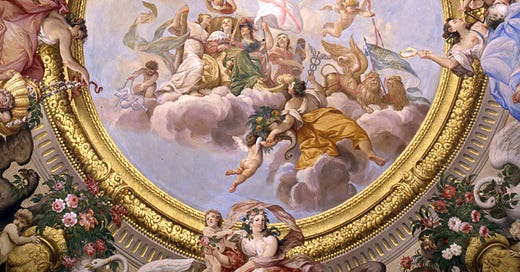


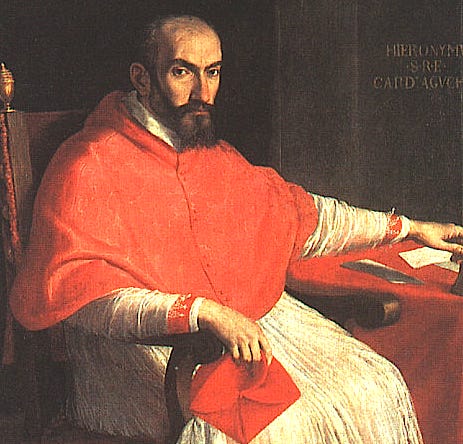

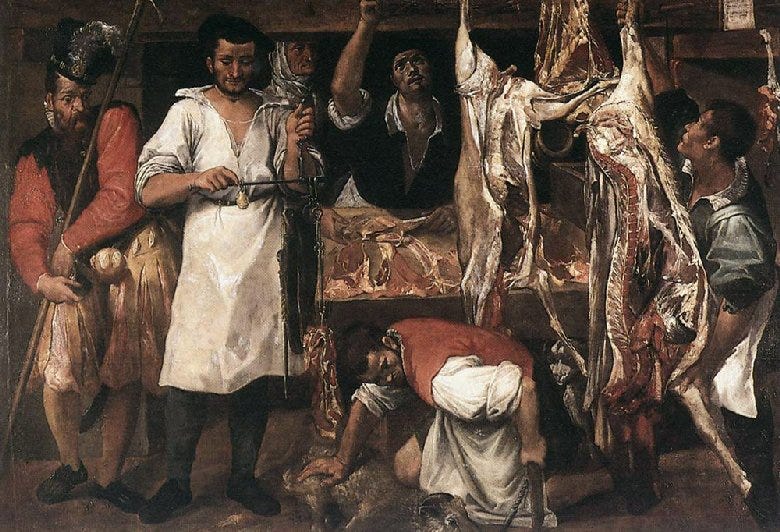


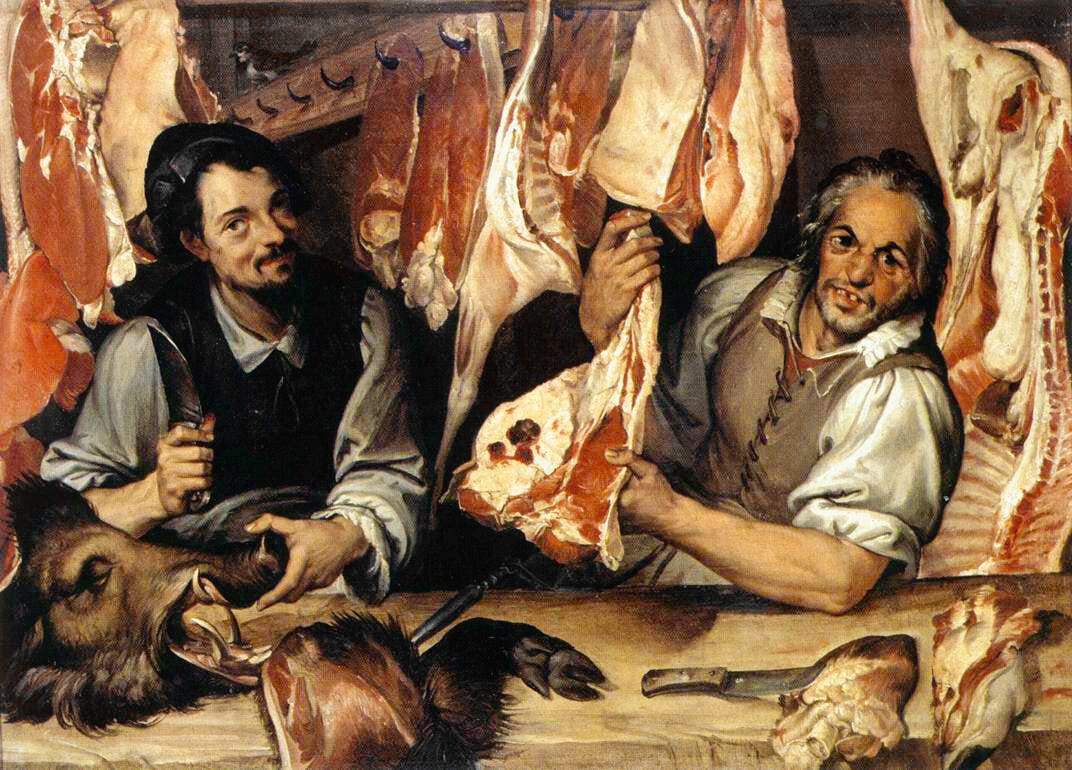
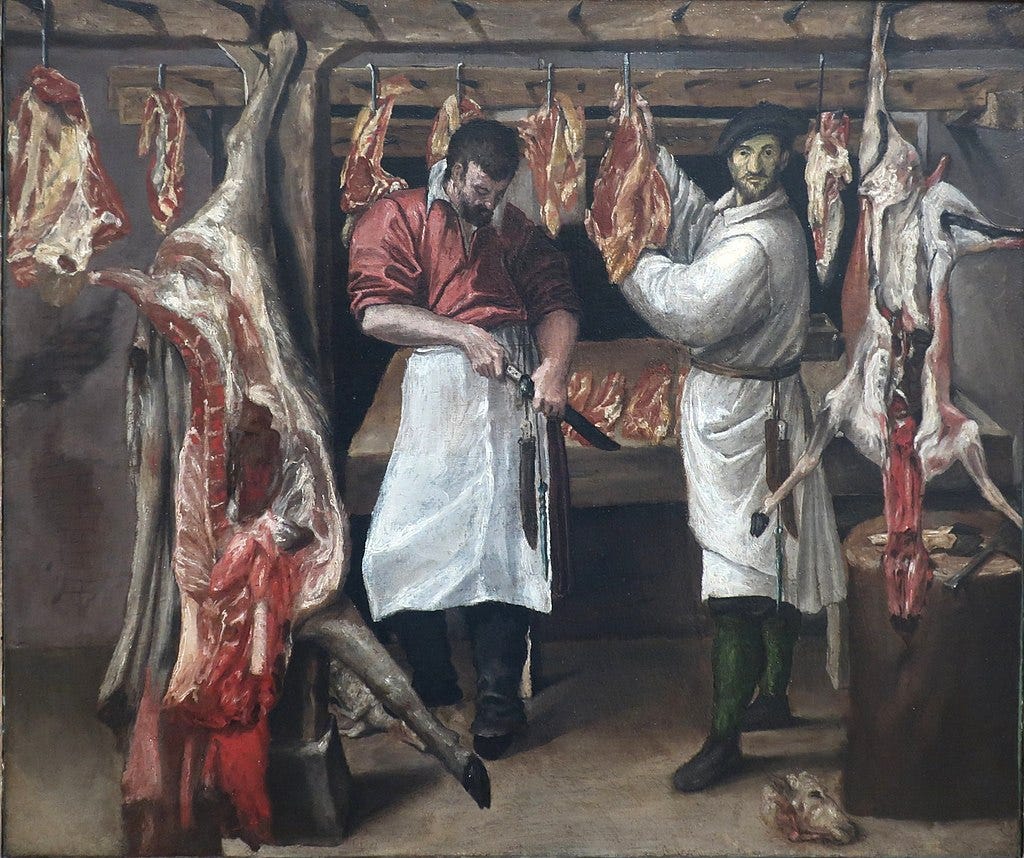
I'm team Giovanni Giorgio, because with all of Giovanni Paolo's arrests, escapes, and oar-chainings, when would he have had the time (and reuptation!!) to write and publish a treatise on arms?